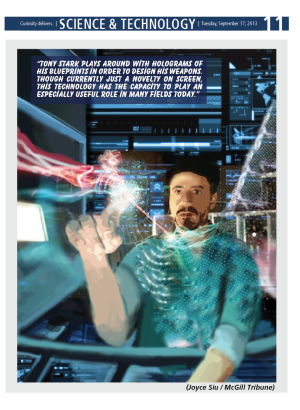Science fiction is a genre known to warn us of the dangers of technological progress, but sometimes it acts as the one to inspire it. In the ’60s, viewers of Star Trek would never have imagined that small pocket phones, microwaves, or automatic doors could be possible in 20 years.
Although we can’t pinpoint exactly what inspires the scientists of today, it is always interesting to look at what technologies are included in modern movies and how close we are to achieving them. This week, we take a look at some of the science that may have inspired Iron Man 3, released this past summer.
3D User Interfaces:
One interesting feature the Iron Man films continue revisiting is the concept of a 3D user interface. Throughout the series, superhero Tony Stark plays around with holograms of his blueprints in order to design his weapons. Though currently just a novelty on screen, this technology has the capacity to play an especially useful role in many fields today.
Inventor Elon Musk and his team at SpaceX, a California space transport company, recognized this application when they designed a 3D user interface to aid in modeling and designing rocket parts and engines. The program uses a Leap Motion controller—a small device with two cameras and three infrared LEDs which allows users to interact with the wireframe of an object that is projected on a screen, similar to Stark’s manipulation of his blueprints. The model can then be produced using a 3D printing technique called Direct Metal Laser Sintering (DMLS).
The user currently only has rudimentary motion control of the model, but this is simply one application of the technology in action. There are other examples of 3D user interface concepts currently in use that have been developed by other groups. The applications range from controlling a robotic arm to browsing an anatomical model during surgery, all of which are accomplished by manipulating a wireframe on screen.
Regenerating Limbs:
Another interesting idea in Iron Man 3 was the Extremis project, developed by Iron Man’s enemy, the Mandarin, to regenerate body parts. The super strength and fire breathing abilities were fun in their own right, but the way it restored amputated limbs was the truly interesting and much more realistic application.
Salamanders and other animals like starfish are able to regenerate their limbs. In fact, adult salamanders can regrow their spinal cord, heart and even parts of their brain.
The regeneration observed in organisms like the salamander is accomplished through a complex system of chemical reactions and immune cells working together at the injury site to repair the wound. It also involves the de-differentiation of cells to their original state: the stem cell. Unlike other cells, stem cells have not yet differentiated into a particular type of cell—like a heart or muscle cell—meaning they have the potential to proliferate into any type of tissue. Therefore, stem cells can adopt the properties of the salamander’s lost tissue in order to replace the limb.
A similar regeneration system is present in mammals; however, due to the scarcity of stem cells, the effect is not quite to the same capacity. Nonetheless, it is well documented that fingertips in humans can heal to about their original state after an accident.
Recent studies in genetically engineered mice suggest that the Wnt-signalling pathway, a signaling system that transmits information from outside the cell to within, is involved in the regeneration of amputated fingertips. Assistant Professor of Dermatology Mayumi Ito from the New York University’s School of Medicine reported his discovery of self-renewing stem cells located in the nail matrix (the part of the nail bed that stimulates nail growth) in a paper published June 2013. This finding, among others, supports the concept that fingertips are able to regenerate to their original state after injury.
The regeneration of limbs is not a novel idea, but it has been researched extensively in recent years due to advances in genetic and biological techniques. These new studies have offered an outlook on the biology of regeneration that may even lead the way to one day restoring an amputee’s limbs.









